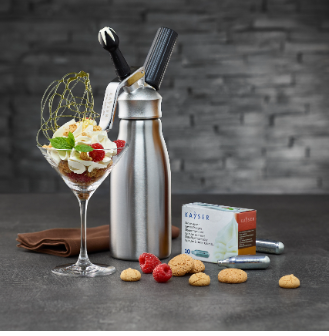Cream chargers have become a ubiquitous tool in both professional kitchens and home settings, revolutionizing the way whipped cream is made and enjoyed. These small, pressurized cartridges contain nitrous oxide gas, which is used to aerate and pressurize liquids, resulting in the fluffy, light texture of whipped cream. Let's delve deeper into the world of cream chargers, exploring their history, composition, uses, benefits, and more.
History of Cream Chargers
Cream chargers have a rich history dating back to the early 20th century when they were first developed for commercial use in the food industry. Originally, these chargers were primarily used in industrial settings, such as bakeries and creameries, to produce whipped cream in large quantities. However, with advancements in technology and manufacturing processes, cream chargers became more accessible to the general public, leading to their widespread popularity in culinary circles.
Composition of Cream Chargers
Modern cream chargers are typically made from high-quality steel and are filled with food-grade nitrous oxide gas. The steel construction ensures durability and prevents any chemical reactions that may compromise the contents of the charger. Additionally, strict quality control measures are in place to ensure that cream chargers meet safety standards and regulatory requirements.
How Do Cream Chargers Work?
Cream chargers utilize the principle of gas expansion to create pressure within the cartridge. When a cream charger is punctured, the nitrous oxide gas inside rapidly expands, creating pressure that forces the liquid contents, typically heavy cream, through a nozzle. As the cream passes through the nozzle, it becomes aerated and whipped, resulting in the desired texture and consistency.
Popular Uses of Cream Chargers
Cream chargers are incredibly versatile and can be used in a variety of culinary applications. From topping off desserts and beverages to creating decorative swirls on cakes and pastries, cream chargers offer endless possibilities for culinary creativity. Additionally, they are commonly used in bartending and mixology to create frothy cocktails and specialty drinks.
Benefits of Using Cream Chargers
One of the primary benefits of using cream chargers is their convenience. With a cream charger on hand, whipping up fresh whipped cream takes mere seconds, eliminating the need for manual whipping or bulky equipment. Furthermore, cream chargers are cost-effective, allowing users to create whipped cream on demand without the need for preservatives or stabilizers.
Common Brands and Varieties
Several brands offer cream chargers in various sizes and quantities to suit different needs and preferences. Some popular brands include iSi, Whip-It!, and MOSA. Additionally, cream chargers come in different sizes, ranging from 8-gram to 16-gram cartridges, allowing users to choose the appropriate size for their specific application.
Safety Precautions When Using Cream Chargers
While cream chargers are generally safe to use when handled properly, it's essential to follow safety precautions to prevent accidents or injuries. Users should carefully read and adhere to the manufacturer's instructions for safe handling, storage, and disposal of cream chargers. Additionally, users should never attempt to modify or refill cream chargers, as this can pose serious safety risks.
Environmental Impact of Cream Chargers
As concerns about sustainability and environmental conservation continue to grow, there has been increased scrutiny on the use of disposable products like cream chargers. While cream chargers themselves are recyclable, the nitrous oxide gas they contain contributes to greenhouse gas emissions when released into the atmosphere. As a result, some companies are exploring alternative methods for producing whipped cream, such as using reusable dispensers or whipped cream siphons.
Legal Regulations Surrounding Cream Chargers
In some regions, there are legal restrictions on the sale and distribution of cream chargers, particularly to minors or individuals with a history of substance abuse. Additionally, businesses that use cream chargers may be subject to health and safety regulations governing the handling and storage of pressurized gas cylinders. It's essential for users to familiarize themselves with local laws and regulations to ensure compliance.
Conclusion
Cream chargers have revolutionized the way whipped cream is made and enjoyed, offering convenience, versatility, and quality. Whether you're a professional chef looking to create stunning culinary creations or a home cook wanting to impress your guests, cream chargers are a must-have tool in the kitchen. By understanding how cream chargers work and following proper safety precautions, you can enjoy delicious whipped cream creations with ease.
Frequently Asked Questions (FAQs)
1. Are cream chargers safe to use? Cream chargers are safe to use when handled properly and according to the manufacturer's instructions. It's essential to follow safety precautions to prevent accidents or injuries.
2. How long does whipped cream last from a cream charger? Whipped cream made from a cream charger typically retains its texture and flavor for several days when stored in the refrigerator.
3. Can cream chargers be recycled? Yes, cream chargers can be recycled. However, it's essential to check local recycling guidelines to ensure proper disposal.
4. Are there any health risks associated with using cream chargers? When used as directed, cream chargers pose minimal health risks. However, inhaling nitrous oxide gas directly from a cream charger can be dangerous and should be avoided.
5. Can cream chargers be used for carbonation? While cream chargers are primarily used for whipping cream, some individuals use them for carbonating beverages. However, this practice is not recommended by manufacturers and may pose safety risks.

